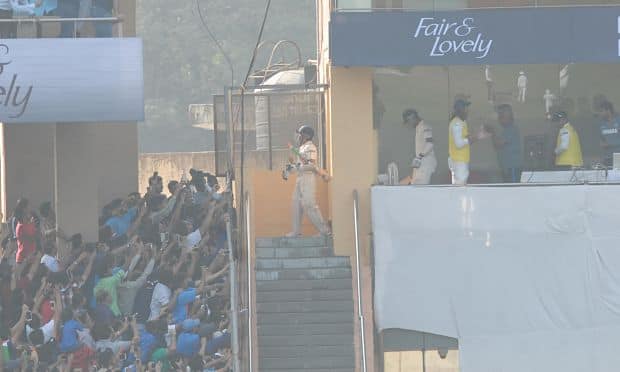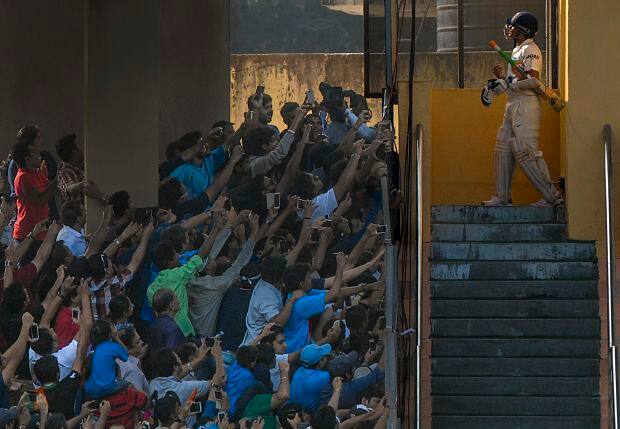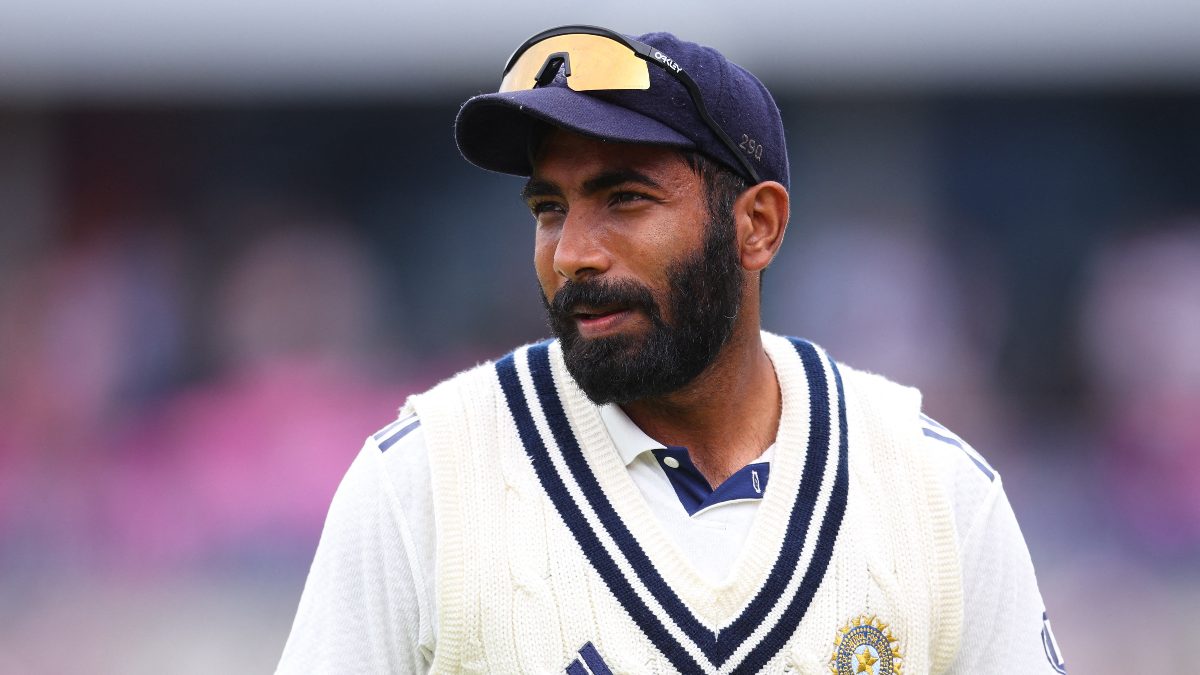A picture is worth a thousand words, it captures the emotions that stay etched in our minds forever. Last year around this time, emotions were running high in the cricketing world – Sachin Tendulkar was playing in his last international match of his career. To the delight of the fans, the final swansong witnessed just about everything - Glimpses of old Tendulkar, the straight drive, the back foot punch through extra cover and the raising of the bat towards the crowd. But during this period, an iconic image emerged from Sachin’s farewell Test at the Wankhede Stadium - that of Sachin Tendulkar walking out to bat for one last time in international cricket and looking towards the heavens. [caption id=“attachment_1804649” align=“alignleft” width=“620”]  Sachin Tendulkar walking out to bat for the one last time in international cricket. Uncropped version. Atul Kamble @ Mid-day[/caption] The picture clicked by Atul Kamble of Mid-day newspaper encapsulated all the emotions in one frame. He won the prestigious Wisden-MCC Cricket Photograph of the Year 2013 award for the photo. We caught up with Kamble to understand the process that went into taking the iconic picture and what the photograph meant to him. It was Sachin Tendulkar’s last match so as a photographer, I had the same amount of curiosity that a die hard cricket fan has. I had this one thing in mind. It was his last match so I needed to click a memorable picture which I would remember forever. My Sports editor Clayton Murzello always tells me “Concentrate on off-beat pictures more and not action”. Most photographers concentrate on action so I had my Sport editor’s instructions in my mind that day. The match started on 14 November and Sachin came to bat that afternoon. Most papers the next day carried a photo of Sachin walking down the dressing room steps with the crowd in the backdrop. I too had clicked that picture but wasn’t impressed with it. But the next day, I told myself, I have to get a good one today. I had prepared myself. I had been covering cricket since 1996 at the Wankhede stadium so I knew in which areas of the stadium you get proper light. In my mind, I knew that there should be a framing of Sachin coming out of the dressing room. At Wankhede, when you get out of the dressing room, the sun light directly beams on you in the gap between the MCA pavilion stand and the main pavilion. Play starts at 9.30 am, so I had taken my position from 9 am itself, exactly opposite the pavilion near the North Stand at the Tata End. After a survey, I thought this framing was proper. The rest of the photographers were approximately 20-25 feet away on either side of me. I positioned myself in such a way that I could see the dressing room staircase, the crowd and the sunlight streaming in. In most cases, Sachin looks towards the heavens after reaching the ground, but given that this was the morning sun and because of its positioning, almost all of Wankhede on the dressing room side is covered with shadow for nearly one hour. So as the sun was beaming in from the gap between the MCA pavilion and the main pavilion, Sachin, who was resuming his innings, came out of the dressing room and glimpsed towards the heaven and I clicked the shot at the right time. Generally, a photographer plays with the light. But since I was getting proper light in that area, I positioned myself so that I could use it to get a good picture. That photo alone tells you why Sachin Tendulkar is called god of cricket in India. I had managed to click just three frames and this one was just about perfect. In my mind there was just one thing, I need to get a good picture. I didn’t know whether there would be a second innings for him to bat but I just tried my level best. As soon as I clicked it, I knew it had come out well. In sports photography, most of the work is done by the camera but you need to have passion and knowledge of the game. And luck also matters. Sometimes you take a good position but a major event happens on the opposite end so despite the hard work, you end up not having that picture. Nowadays you get cameras which can shoot 7-8 frames per second, I had a camera which produced just three. But you need to have the confidence and awareness about what exactly you want to shoot. A sports photographer has to get his timing right, a fraction of second here or there and the crunch moment is missed. You need a fast camera. I had a moderate one - not a hi-fi one. But the person behind the camera is also important. The camera can only maintain your quality. Of late, people have 24 megapixel camersa but I had a 10 megapixel one - a Nikon D200. But I won’t say that if I had a higher configuration camera, the picture could have come out better than this. Quality matters. A good player doesn’t change his shot if given a different bat. It wasn’t difficult for me to click this picture because if you have the position and you are clear in your mind then you get what you want. But a little bit of luck also plays a part. If Sachin hadn’t looked towards the heavens then there would have been no meaning to this picture. If you visit Pandharpur, the main centre of worship for Hindu deity Vitthala, you will find huge number of devotees lining up for his darshan (blessings). So when I see this picture, I am reminded of Vitthala darshan where the the god comes out and the devotees are lining up for one last worship. This is one of the best pictures I have clicked in my career. It was one of the most emotional pictures I have taken in cricket. Later, I got a mail from one of my friends informing about the MCC–Wisden Photo of the Year competition in which one applicant can send maximum three pictures. I sent in two pictures of Sachin including this one and the one where he touches the pitch in the end and another one of Prithvi Shaw. One of my best friends and well-wishers Vikas Khot - the photo editor of Forbes India Magazine - helped me select these three pictures. He also helped me crop it and made me understand the proper composition. As much credit I have got for this picture, the same amount of credit goes to Vikas. [caption id=“attachment_1804651” align=“alignleft” width=“620”]  The cropped version which won the MCC-Wisden photo of the year award. Atul Kamble @ Mid-Day[/caption] I had shot a wide picture, so off the 100%, 60% was chopped off and the main composition was 40%. Most photographers shoot it wide and then crop it. The picture went through just cropping and not any photoshopping. It was purely natural. When I won the award for the picture of the year 2013 and when MCC-Wisden came out with that picture, at that time only people came to know about the importance of it. Surprisingly, it had went unnoticed until then and literally, many of my photographer friends checked whether they had shot this kind of picture but they didn’t and told me that your position was good. I then saw the judging process on Lord’s Tv and one of the judges Mr. Patrick Eagar, we can call him the Bradman of photography, said, “It’s a lovely photograph, Sachin in his last Test and it’s like a Leonardo da Vinci painting, you’ve got the sunlight just catching the master and then the crowd all of whom who have got a mobile phone or a camera taking photographs. Their adoration is there and it’s a wonderful photo, it’s really lovely.” Getting such an accolade from such a legendary person was a big achievement for me. The feeling is just like that of a new batsman being told by Sachin Tendulkar that your batting is really good. Mr. Eagar has covered 325 Test matches and has been taking photographs of cricket for over 45 years. The judges were legends. There were about 500 photographs submitted in the contest and then they filtered it down to eleven of which this picture was selected as the picture of the year. Mr. Eagar was happy that such a memorable photo emerged from the legend’s last match. Chris Smith, Chief Sports Photographer at The Sunday Times and Chair of the Judging Panel, said, “In the end the sheer sense of occasion that the winning image captured won us over.” Of all the awards I have received so far, this one is the biggest. It was viewed by approximately four crore 59 lakh people and has been displayed on the Warner stand wall at the Lord’s ground. I couldn’t believe it, earlier 2-3 of my pictures had become hits but the viewing never went above one crore! On the last day, I knew that, Sachin would take a lap of honour so I tried very hard to go on the top. I knew this was another good position but somehow, I didn’t get there on time. But after I finally did manage to get there, on the top floor of Garware Pavilion, Sachin suddenly walked back towards the 22-yard strip, I was shooting at that time and the moment he touched the pitch, tears started rolling out of my eyes. I clicked the picture and tried to control my emotions as in our photography school we are taught not to get emotional, and try instead to bring out emotions in the picture. But my tears didn’t stop and still, I continued shooting. It was a touching moment. Of all the pictures I clicked in the farewell match, the two pictures that stand out for me are this one and the one where Sachin touches the pitch.
The picture clicked by Atul Kamble of Mid-day newspaper showing Sachin looking to the heavens one last time, encapsulated all the emotions in one frame.
Advertisement
End of Article


)

)
)
)
)
)
)
)
)



